Umm al-Fahim 2 May 2007
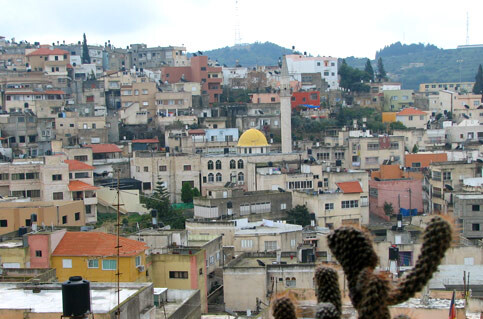
The town of Um El Fahim in present-day Israel is home to 48,000 Palestinian citizens of Israel. Most are internal refugees denied services by the state equal to its Jewish citizens or the right to return to their original land.
Fifty-nine years ago last month, the militant Zionist Irgun and Stern Gang systematically murdered more than 100 men, women, and children in Deir Yassin. The Palestinian village lay outside the area the UN recommended to be included in a future Jewish State, and the massacre occurred several weeks before the end of the British Mandate, but it was part of a carefully planned and orchestrated process that would induce the flight of 70 percent of the native population to make way for an ethnically Jewish state.
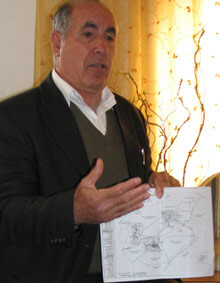
Sitting in his home, Adnan holds a map of his village Lajjun and talks about his memories of his home and 1948.
Our group met in the home of Adnan, a refugee from another village called Lajjun who now lives in Um El Fahim town in Israel. A well-dressed man in his late sixties, Adnan welcomed us into his living room when we asked to hear his story. His grown son brought around fresh strawberries and fancy chocolates before sitting down to translate as his father began to speak:
I remember Lajjun as if in a dream. I was only seven years old when the men with guns came, but I still remember certain things so clearly. I remember my school, and the name of my teacher. I remember we had a community center for visitors, and the village was very excited because an English ambassador was planning a visit. We worked for weeks renovating the big gardens in anticipation. I remember our village had a strong spring and a sophisticated water system. Israel has succeeded in convincing the world that Palestinians were primitive and uneducated until the Zionists arrived, but that is propaganda. We even had developed agricultural tools like trucks to turn corn. We were well-educated and we had good relations with our Jewish neighbors living in a kibbutz several kilometers away.Almost all the residents of Um El Fahim are internal refugees from 1948 like Adnan. They live as second-class citizens, receiving fewer services than their Jewish counterparts. Israel spends an average of 4,935 shekels ($1,372) for each Jewish student per year, compared to 862 ($240) per Arab one. In the words of the Israeli parliamentarian Jamal Zahalka, “Israel is a democratic state for its Jewish citizens, and a Jewish state for its Arab citizens.”Then the soldiers came. I remember them shooting from atop a mountain, bullets flying over my head as we ran. We fled to a town called Taybi, taking nothing with us — we had no time, and assumed we would be back when the war was over. In Taybi we had to borrow woolen tents to live in. Eventually we found our way to Um El Fahim with thousands of other refugees, and we’ve been here ever since. Our village had 44,000 dunums of agricultural land and they took every last one of them. We are citizens of Israel, but never allowed to return to our land and our homes nearby. We are refugees in our own state.
Between 1948 and 1966, Palestinians in Israel lived the way Palestinians now live in the West Bank and Gaza. We were prisoners in our homes in Um El Fahim, under constant curfew, controlled by checkpoints, etc. Although certain restrictions have been lifted, as non-Jews we are still generally refused from more than 93 percent of the land in Israel, owned by the state or the Jewish National Fund. That includes my land, my village. They’ve surrounded it with a fence and won’t even let us go pray in the mosque, one of the only structures still standing. The mosque belongs to the nearest kibbutz now, so Jewish kibbutzniks can visit it when they please.
How can Israel call itself a democracy when I cannot go to my land simply because I am a different ethnicity from my old Jewish neighbors? What kind of a democracy is this where political parties can’t challenge the Zionist exclusivist framework, but they can challenge the rights of the indigenous population to stay here? Israeli Minister of Strategic Affairs Avigdor Lieberman came from Russia a few years ago, and now he’s talking about sending Palestinians away, we who’ve been here for hundreds if not thousands of years! The Jewish people know catastrophe and suffering. They work for justice in their own lives … why not in mine?
Several elderly Um El Fahim residents accompanied us on our trip to Kafrayn. It was a strange thing, driving around in a bus looking for a village that no longer exists. Before we’d reached Kafrayn, one elderly Palestinian named Muneeb jumped up and began motioning outside the window: “That’s it! That’s my village!” I turned to see several hills covered with trees. Like so many others, Muneeb’s village (near Kafrayn) had been emptied of Palestinians and then planted over with fast-growing Jerusalem pines by Zionists who would later brag about “making the desert bloom.”
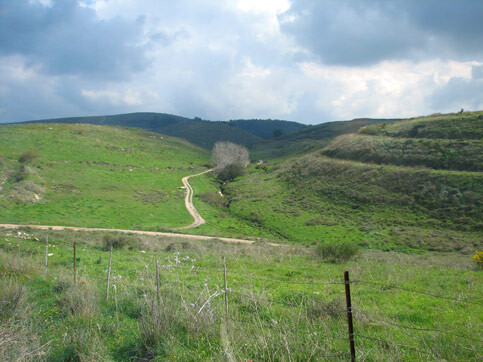
Kafrayn village, fenced off and designated as military and grazing grounds. Most Palestinians refugees’ land remains empty but controlled by kibbutzim or the Jewish National Fund, off-limits to the Palestinians.
Muneeb pointed excitedly towards one part of the hill: “That’s where I used to walk to school! And that’s where we’d go to fetch water! And that — that’s where my house was …”
Suddenly Muneeb’s voice cracked and he looked down, embarrassed. “I shouldn’t have come here today,” he confessed after regaining his composure. “It’s too emotional. You were here thousands of years ago and you miss your land,” he spoke to the Jews in our group. “I was here fifty years ago and I miss my land.”
What most struck me about our drive was how bare everything was. Nobody was living in Muneeb or Adnan’s villages, or anywhere near them. Their villages had been turned into forests, military bases, and grazing land, controlled by kibbutzim sometimes many miles away. One Israeli on the tour explained to me that Israel typically develops large land-intensive projects to maintain control over empty areas where it doesn’t want Palestinians to settle. When we arrived in Kafrayn, we found several empty fenced off areas. One was labeled “Welcome to military base 105.” Another posting said “Danger: Firing Area - Entrance Forbidden!” A third sign read “Cattle-grazing land.”
“So they let cows live here but not Arabs?” I asked my new friend.
“Cows don’t have nationalist aspirations,” he smiled. “Besides, do you even see any cows around here?” He was right — there were no cows in sight, nor soldiers for that matter.
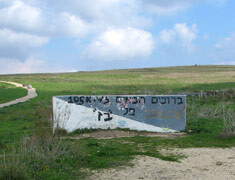
A sign reading “Welcome to military base 105” near the ruins of Kafrayn village.
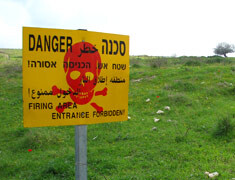
A sign reading “Danger: Firing Area - Entrance Forbidden!” near the ruins of Kafrayn village. There are so soldiers in sight, but villagers are forbidden from returning.
One common misconception about the Palestinian refugees’ right of return is that its implementation would create a new refugee crisis by displacing most Israelis. In fact, according to Dr. Salman Abu Sitta, a former member of the Palestine National Council and researcher on refugee affairs, “78 percent of [Jewish Israelis] live in 14 percent of Israel. The remaining 22 percent of [Jewish Israelis] live in 86 percent of Israel’s area, which is Palestinian land. Most of them live in a dozen or so Palestinian towns. A tiny minority lives in Kibbutz … Thus, only 200,000 Jews exploit 17,325 sq. km, which is the home and heritage of 5,248,180 refugees, crammed in camps and denied the right to return home” (See Dr. Abu Sitta’s highly recommended Nakba Map, available at http://al-awdacal.org/shop.html).
The issue is not about space, it’s about demographics. Allowing Palestinian refugees to return would threaten the ethnic character of Israel. Rather than being the state of the Jews, it might have to become the state of the people who live in it, some of whom are Jews, some of whom aren’t. But until that happens, the most people like Muneeb and Adnan can look forward to is an occasional tour with Jewish fringe activists every few decades. Some of the Kafrayn expulsion survivors who accompanied our tour had not been back since 1948 — almost 60 years. They wandered around, as if in a dream, pointing out where the old cemetery and school used to be. One survivor, Abu Ghasi, recalled his story for the group:
“We had all heard about the Deir Yassin massacre a few days before, so when the Zionist forces arrived and began shooting, we all ran. Those of us who survived took shelter in a nearby village, and soon we heard the blasts that we knew were our homes being exploded. After the Jewish forces had moved on, we returned to find our village completely obliterated. It was clear we had no alternative but to move elsewhere, and eventually we settled in Um El Fahim.”
An old woman from the nearest kibbutz spoke with the survivors and all agreed that their communities had gotten along well before the expulsion. They reminisced about a school bus driver they had shared, and the woman confirmed their story about the Zionist forces razing and bombing Kafrayn. The tour ended with a communal lunch between survivors, kibbutzniks, and the rest of the group next to Kafrayn’s old springhouse and main water source.
Somebody had painted “Death to Arabs” in Hebrew on the springhouse before we arrived, but we didn’t let that keep us enjoying the spring’s natural beauty as several people got up to speak. One Jewish woman who had immigrated from Canada to Israel 27 years ago said it took her the first 20 to really understand the truth about Israel’s past and present. One man asked the kibbutznik woman if she thought her Palestinian neighbors should be allowed to return, but she was unwilling to give a straight answer, saying it was complicated. An Israeli man responded to her with frustration, saying, “We are here on 100,000 dunums of empty land. We have in Israel many internal refugees from this land that lies empty. Why not give families just one of their thousands of dunums to let them come back to their homes?”
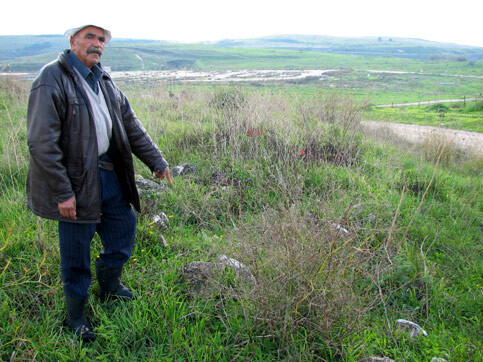
Abu Ghasi points out where the Kafrayn cemetery used to be.
A Kafrayn survivor addressed the kibbutznik as well: “Look, we all want peace. It’s very easy to say, but peace requires making an effort. I’ve lost 60 years on my land. How can you expect me to live in peace with the Jews if they refuse to give me back my land and my rights?” Another refugee echoed his sentiments: “Peace does not look like one type of person enjoying land and others forbidden. If you want peace, let’s share everything. Let’s live together.”
The Palestinian refugees on our tour are the lucky ones. Unlike the two thirds of Palestinians who are in the diaspora, Adnan, Muneeb, and Abu Ghasi are still here, in historic Palestine. And although not as privileged as Jews, they are at least not living under Occupation like their West Bank and Gaza refugee counterparts. This year, I spent Deir Yassin day in Izbat At Tabib, a village of 226 Palestinians refugees from 1948 whose families resettled in the West Bank and have been facing repeated attempts by Israel to expel them a second time. Almost the entire village is under demolition order to clear the way for settler roads and the Wall.
Not only have the massacres and expulsions of the past never been officially acknowledged, but the Nakba goes on in some form or another for all Palestinian refugees today, whether in Israel, the West Bank, Gaza, or the diaspora. This is not ancient history — this is now, this is urgent. The Nakba continues. Deir Yassin continues.
All images by Anna Baltzer.
Anna Baltzer is a volunteer with the International Women’s Peace Service in the West Bank and author of the book, Witness in Palestine: Journal of a Jewish American Woman in the Occupied Territories. For information about her writing, photography, DVD, and speaking tours, visit her website at www.AnnaInTheMiddleEast.com
Related Links





